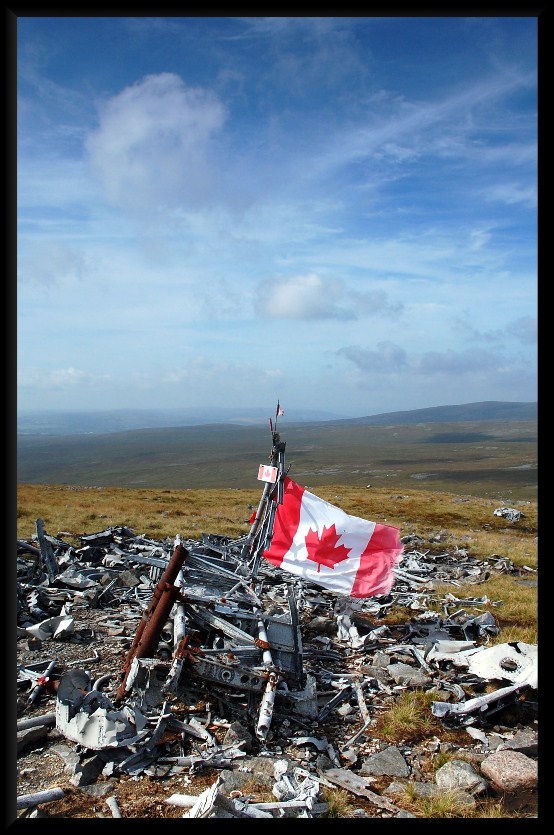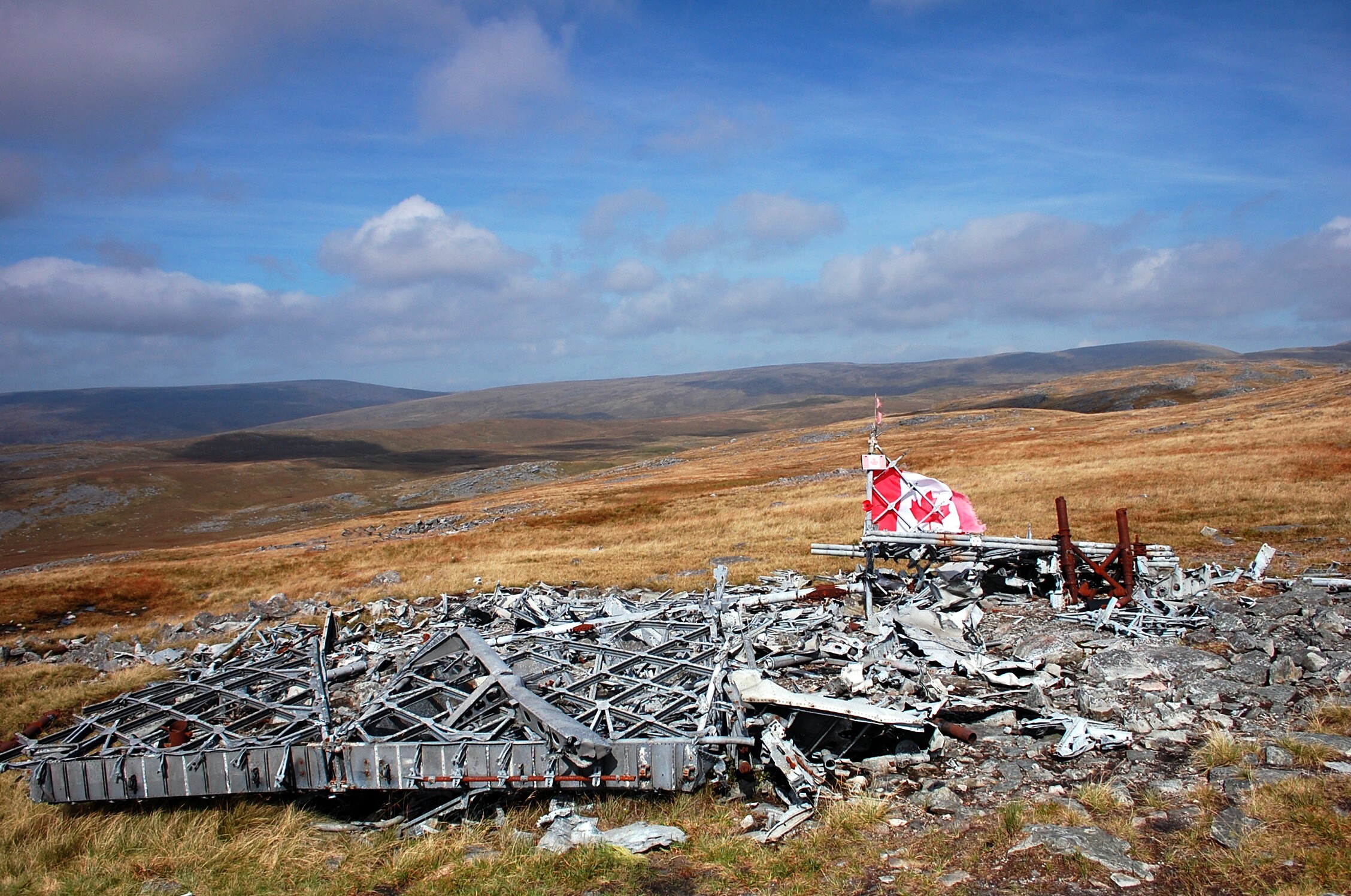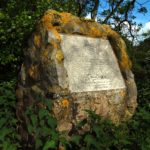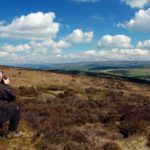Wellington bomber MF509
‹ Return to Air Crash Sites

Wellington bomber MF509, Brecon Beacons
This is one of the most celebrated and visited of air crash sites (because of the amount of wreckage remaining). Canadian crewed Wellington MF509 crashed in the Brecon Beacons in south Wales on November 20th 1944 with the loss of all crew members.

The Wellington was flying from RAF Stratford on a night navigation exercise. Wireless Op Sgt Burke had requested permission to descend below the cloud base because they were experiencing problems with the starboard engine, though what the pilot had in mind is unknown – was there icing in which case descending might have caused that to melt or was he hoping to put the bomber down somewhere? No-one knows for sure, because shortly afterwards the bomber flew into the hillside at Carrag Goch.
CREW
Sergeant Charles Hamel (Pilot) aged 21
Sergeant Jules Robert Rene Villeneuve (Navigator) aged 22
Flying Officer William Joseph Allison (Bomb Aimer) aged 28
Sergeant Joseph Paul Ernest Burke (Wireless Operator / Air Gunner) aged 20
Sergeant Arthur Grouix (Air Gunner) aged 22
Sergenat Gerard Dusablon (Air Gunner) aged 20
MF509 was one of three Wellington bombers from 22 OTU lost that night, all with starboard engine problems;
Canadian pilot P/O Nezan managed to crash land Wellington MF505 at RAF Wellesbourne Mountford with none of the crew being injured.
Wellington LN460 had less luck. A fire broke out in the starboard engine nacelle which could not be extinguished. Three of the crew were able to bale out, but the 3 Canadian crewmen remaining went down with their aircraft which crashed in a huge explosion on farmland south of Evesham. They were;
Pilot Officer Duncan McKenzie Roy (Pilot) aged 29
Flight Sergeant Fred Knowles (Wireless op / Air Gunner) aged 23
Sergeant Alexander Angus Cameron (Air Gunner) aged 19
Please see the comment below (29 October 2019) by Bill Grey regarding the Canadian flags at the site.





Another sad loss Ian. great info and images. The lower one shows off nicely the famous Barnes Wallis designed geodetic structure the Wellington was reknowned for. My Dad trained on ‘Wellies’ as a rear gunner shortly before the war luckily ended – otherwise I might not be typing this now 🙂
Your getting about a bit of late Ian!! Special trip? or just a weekend away 🙂
Looks like another slowly rising high ground impact scenario… a few more feet and he would have cleared the ridge?
Well researched Ian . It looks as warm as it felt in these shots . A remarkable amount of wreckage at this site , unusually the Geodetic framework rather than the more usual heavy metal bits !
The addition of the Canadian flag is a welcome splash of colour too !
A great day out this the first of three sites on the day , looking forward to the others !
[http://www.flickr.com/photos/29288836@N00] It is odd to think how things might have panned out. My Dad went off to join the RAF in 1938 but joined the Royal Navy instead on a whim, would almost certainly have ended up in a Wellington or a Hampden, statistically resulting in me not being able to reply to you either! [http://www.flickr.com/photos/richardtierney] Hi Richard, this was a day trip, Paul very kindly drove down (I say very kindly, truth is he hates my driving) but it was a long haul all the same, 9 hours driving there and back with an 8 mile walk in between. Dunno about the altitude thing, I think they may have been descending when it struck the ground, though they could have been flying level in which case yes a few more feet might have seen them clear. [http://www.flickr.com/photos/pasujoba44] Ta mate and thanks again for driving, really. As Rob says it is good to see that geodetic framework, it has survived very well. I was reading on Sean’s post about someone in Preston who wanted to haul this off the mountainside and have it as a garden ornament, but he was prevented from doing so of course.
I’m glad to hear that the wreckage is staying where it is. Very very sad; another bunch of lads whom lost their lives in their prime. Nice to see the museum aircraft as a comparison. I wonder what caused these engines to fail, could it be a common fault to all or just a coincidence that they were all starboard side? Excellent research again and a good trip out for you Ian 🙂
Three with the same problems? Wonder if one of the ground crew made the same mistake on all three aircraft, contributing to engine failure. Was the flag your tribute? Looks a wee bit tatty, so I’m guessing a previous visitor left it perhaps.
Incredible location Ian. Looks a fab day.
I guess the size leads to the remains to some extent but this would not be that accessible either I would have thought. The surrounds are beautiful as you are aware and you’ve put together another piece to the book
[http://www.flickr.com/photos/reflectionsreturn] [http://www.flickr.com/photos/15421769@N05] [http://www.flickr.com/photos/cachelog]
I don’t know if it was all due to the same problem, probably just a coincidence that all three had problems with the starboard engine. It was really common for aircraft to crash, so these sort of coincidences were just more likely. For instance during that one month – November 1944 – Operational Training Units (OTUs) around the country lost a total of 29 Wellington bombers in crashes and accidents with the loss of 44 airmen and 3 civilians on the ground. It was the case Amy that bombers used for training purposes had served operationally and so were more likely to have been damaged and then patched up again. The pressures of war made it so that new aircraft were not available for training.
The flag was already there by the way, but we unfurled it, the wind had wrapped it around a piece of metal.
Bryan, I understand the Brecon Beacons National Park Authority have been instrumental in preserving air crash sites and actively promoting them as places of historical interest. I have a small booklet from 1996, produced by the Brecon Beacons National Park Authority (and kindly sent to me by another flickr member) which was for this purpose – remembering and respecting the sites. Other National Parks, I have been told, have been complicit with people who have removed wreckage, ostensibly for it to be displayed in a museum which either doesn’t exist or the display never materialises (for that read; it ends up in someone’s garden shed).
Great tribute..
[http://www.flickr.com/photos/maycontaintracesofnuts]
Yes this crash site in some ways proves our point that it is better left on the hill . The local park authority and the locals themselves are using the site to encourage people onto the hill and in turn that will hopefully generate income in the villages . That may seem at first glance a little off , using the sites as tourist attractions essentially . But the point is that when doing this the men are remembered and indeed more people become aware of the tragedy that happened over Britain throughout the war in training our airmen . The more people who know,the longer the men and their sacrifice willl be remembered.
the canadian flag really does make it human,and tragic,ian…
The Canadian flag was brought to Wales by a Canadian who was in touch with the families of the crew of the bomber. A local hill walker has replaced the flag on several occasions when it became wind blown and torn.
In recent years on the anniversary of the crash, the flag has been replaced by Carl Ryan a member of the group which was formed initially to help relatives of the crew visit the site
great photos ian , but a sad story
amazing history, i wonder who preserves the flag there
A few respectful people erect flags on site, but one or two locals place a flag there when needed. The locals involved organised the visit of the family of Bill Allison, bomb aimer, to the site in 2013.
amazing site Ian, noticeably gentler terrain compared to yr other Welsh shots. shame they didn’t make it, the slope looks moderate enough to land on [if desparate being in a bomber!]. great to see the amount of debris still remaining, i agree Paul [http://www.flickr.com/photos/pasujoba44] great idea to have more folks visiting accessible sites. could even be a place of pilgrimage for Canadian visitors, ‘drop in and see yr boys’ you know. i’m surprised some clever bastard hasn’t come up with the idea for tours of selected sites – catered to different fitness levels [10% commission please if any one picks up on this idea and runs with it! ;)]
[http://www.flickr.com/photos/maycontaintracesofnuts]
[http://www.flickr.com/photos/amybigkiss] i could be wrong for bombers, but fighter crew had their ‘own’ groundies responsible for keeping each aircraft airworthy? given the number of aircraft of each type that were operating at that time, it wouldn’t surprise me if there were a number with a similar or even same tech issue. i know of a fleet of a mere 19 aircraft operating commercially, and you’d be surprised how many would raise the same tech issue around the same time.
Fantastic history..wonderful shots. It’s a pleasure to see these.
I recorded a few programmes whilst I was away. Not sure if you know about "WW2 Digs with Dan Snow" on BBC2 on Fridays? Anyway, thought I’d mention it.
[http://www.flickr.com/photos/mickb6265] [http://www.flickr.com/photos/29730035@N04] [http://www.flickr.com/photos/tomitheos] [http://www.flickr.com/photos/25305713@N04] [http://www.flickr.com/photos/angwickham] [http://www.flickr.com/photos/nondesigner]
Thanks very much guys. Not sure who put the flag there, a visitor during the Olympics? Judging by the amount of colour it still has it may not be more than a couple of months old. Ang people already do tours to wreck sites. Paul and me have done a couple. But I personally wouldn’t want to earn money off the back of them though. Could be right re; the same problems developing, though.
[http://www.flickr.com/photos/reflectionsreturn] Yeah think I saw that Mark, same one with the stuff about U-boats?
See my post above – a local hillwalker part of a group who were in touch with the families of the aircrew, placed the flag which was brought over by a Canadian in 2006. The flag is regularly replaced when it becomes worn by one or two of the group members. The sister of the bomb aimer and other members of her family visited the site accompanied by the group members.
The sister referred to above was Phyllis Allison Burns sister of William Allison. Phyllis visited the site in 2013 but regrettably passed away in 2020.
Agreed . Wonderful shot and also amazed that there is so much wreckage still there.
They featured a crash site memorial on the BBC breakfast news a couple of weeks back. You probably already knew that, but if not, http://www.bbc.co.uk/news/uk-scotland-19317762
Sad yet beautiful photo, Ian.
[http://www.flickr.com/photos/pasujoba44] Paul, the problem of using different sites of tragic war events as tourist attractions, is particularly striking in my hometown, when in the summer season there’re everywhere banners and leaflets inviting tourists to visit KL Auschwitz. Nothing wrong with organizing toursit tours to the KL of course, but a bit more tact would be needed. Recent tours "KL Auschwitz and Wieliczka Salt Mine in one day!" really sound like someone went too far. What will be next, ""KL Auschwitz, Wieliczka Salt Mine and Pub Crawling in one day"?

[http://www.flickr.com/photos/stopherjones]
Thanks Chris, thanks for the link. As it happens Amy sent me the link last month, I made a mental note to visit that site – one of hundreds I’d like to visit in Scotland. Odd to think in my youth I climbed Ben MacDui several times, unaware of that, or any other wreck site, close to where I was walking.
[http://www.flickr.com/photos/bazylek]
Thanks Robin. Yes it needs to be sensitive. Both Paul and I have visited Auschwitz, dunno about Paul but it all seemed in good taste to me, but I was only there for a short visit, you will see much more of course. What you describe does sound objectionable. That lack of respect can only beget a further lack of respect. Reminds me of a visit my wife and I made to New York, 6 months after 9/11. There we saw a sign advertising "The closest bar to Ground Zero!"
[http://www.flickr.com/photos/pasujoba44] [http://www.flickr.com/photos/29551624@N03] [http://www.flickr.com/photos/bazylek]
There is though the well established phenomenon of Dark Tourism….
en.wikipedia.org/wiki/Dark_tourism
[http://www.flickr.com/photos/maycontaintracesofnuts] That’s the one Ian, glad to hear you didn’t miss it 🙂
Another well documented narrative Ian and lovely photo. Unfortunate to have all those young men die in training accidents.
Also thanks to the person who left the Canadian flag!
The first flag was hoisted in 2006 and it was brought over by MrWes Cross of McGill University Monreal. He had been researching Canadian students from the University who had perished during WW2. Phyllis Alison sister of the bomb-aimer sent the acrylic placque which was attached to the cairn by Arwel Michael, John Richards and myself – Bill Grey. Phyllis didn’t visit in 2006 due to ill health, but eventually when recovered she and her family visited the site in 2013. The flag is replaced whenever it becomes tattered by the weather by one or two of the original group who helped the Canadian families.
Thanks Bill, I have often wondered who placed these flags, it’s lovely to read this. I’ll reference your comment in the main text above.
Ian
Yes, the flag does add a focal point to add to the poignancy.
whats the easiest way to this site , i would love to visit it to pay my respects to those canadian young men who died for our freedom and democracy
easiest is probably the shortest from Glyntawe, bit steep at the start but only a couple of miles to the crash site at grid ref SN 81618 16921
Ian
My Uncle is Sgt Jules Robert Rene Villeneuve. He is lovingly remembered. He was my Father Henry’s youngest brother. My Grandmother Clara had four sons serving all Metis ( Indigenous and French) Henry Gaspard Villeneuve, Arthur Villeneuve, Jules Robert Rene Villeneuve and Earl Scofield whose photo was featured on the cover of a booklet of Metis Veterans. R.I.P. Our sister Kathleen ‘Kay’ Villeneuve visited and photographed Uncle Jules’s gravesite in Chester, England. We have a nephew (my brother John’s first son) Jason ‘Jay’ Major ( a pilot) presently serving with the Canadian Military in Colorado Springs soon to return to base in Canada. Welcome to Gboard clipboard, any text you copy will be saved here.
A traditional commemoration ceremony in keeping with Metis tribe custom was performed in 2006 with traditional items btought from Canada presented by the late half brother of Jules Villeneuve, a senator of the Metis tribe.
It was a very solemn ceremony.
Bill Grey
When I was a young boy, aged about ten in the year 1944 a bomber crashed near my home at Wellington Heath, nr Ledbury, Herefordshire. It crashed very close to the village church. I believe the crew were Canadian and all bailed out safely. I am now in my eighty seventh year but remember the crash so clearly, but, I’ve searched and asked folks, also I’ve trolled through the websites but find nothing relating to the crash. I would like to find out what type and make the bomber was. I seem to think that maybe it was a Wellington or a Whitney! All the existing folks who lived in this village have now sadly passed away. Can anybody out there help me? Many thanks if you can. Andy Gurney
Hi Andy,
I am afraid the books I have don’t cover that part of the country. A quick google around revealed the only incident during WW2 was a Percival Proctor III, a 3 seater trainer aircraft which “crashed in forced landing Peg’s Farm, Wellington Heath, 2 miles N of Ledbury” according to an entry on RAF Commands. There is not much other detail, not even certain of the date (21 January 1943?). The aircraft number provided is R7564 of No 4 Signals School.
But this doesn’t fit with your memory really. Hopefully someone looking at this page will be able to help?
Ian
LN460 had a Canadian gunner/wireless operator called Fred Knowles who died in the horrific accident. He’s buried at Denton cemetery in Manchester. Does anyone have any information about Fred and why he is buried in Denton ?